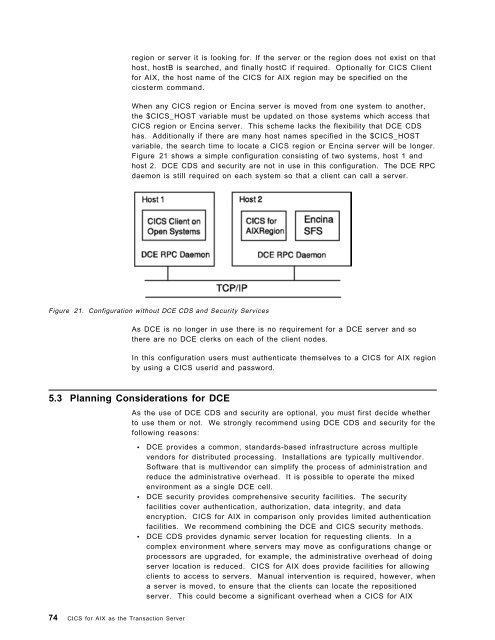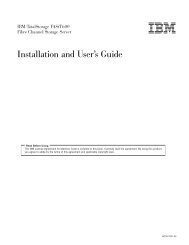Addressing OLTP Solutions with CICS: The Transaction Server ... - Ibm
Addressing OLTP Solutions with CICS: The Transaction Server ... - Ibm
Addressing OLTP Solutions with CICS: The Transaction Server ... - Ibm
Create successful ePaper yourself
Turn your PDF publications into a flip-book with our unique Google optimized e-Paper software.
egion or server it is looking for. If the server or the region does not exist on that<br />
host, hostB is searched, and finally hostC if required. Optionally for <strong>CICS</strong> Client<br />
for AIX, the host name of the <strong>CICS</strong> for AIX region may be specified on the<br />
cicsterm command.<br />
When any <strong>CICS</strong> region or Encina server is moved from one system to another,<br />
the $<strong>CICS</strong>_HOST variable must be updated on those systems which access that<br />
<strong>CICS</strong> region or Encina server. This scheme lacks the flexibility that DCE CDS<br />
has. Additionally if there are many host names specified in the $<strong>CICS</strong>_HOST<br />
variable, the search time to locate a <strong>CICS</strong> region or Encina server will be longer.<br />
Figure 21 shows a simple configuration consisting of two systems, host 1 and<br />
host 2. DCE CDS and security are not in use in this configuration. <strong>The</strong> DCE RPC<br />
daemon is still required on each system so that a client can call a server.<br />
Figure 21. Configuration <strong>with</strong>out DCE CDS and Security Services<br />
As DCE is no longer in use there is no requirement for a DCE server and so<br />
there are no DCE clerks on each of the client nodes.<br />
In this configuration users must authenticate themselves to a <strong>CICS</strong> for AIX region<br />
by using a <strong>CICS</strong> userid and password.<br />
5.3 Planning Considerations for DCE<br />
74 <strong>CICS</strong> for AIX as the <strong>Transaction</strong> <strong>Server</strong><br />
As the use of DCE CDS and security are optional, you must first decide whether<br />
to use them or not. We strongly recommend using DCE CDS and security for the<br />
following reasons:<br />
• DCE provides a common, standards-based infrastructure across multiple<br />
vendors for distributed processing. Installations are typically multivendor.<br />
Software that is multivendor can simplify the process of administration and<br />
reduce the administrative overhead. It is possible to operate the mixed<br />
environment as a single DCE cell.<br />
• DCE security provides comprehensive security facilities. <strong>The</strong> security<br />
facilities cover authentication, authorization, data integrity, and data<br />
encryption. <strong>CICS</strong> for AIX in comparison only provides limited authentication<br />
facilities. We recommend combining the DCE and <strong>CICS</strong> security methods.<br />
• DCE CDS provides dynamic server location for requesting clients. In a<br />
complex environment where servers may move as configurations change or<br />
processors are upgraded, for example, the administrative overhead of doing<br />
server location is reduced. <strong>CICS</strong> for AIX does provide facilities for allowing<br />
clients to access to servers. Manual intervention is required, however, when<br />
a server is moved, to ensure that the clients can locate the repositioned<br />
server. This could become a significant overhead when a <strong>CICS</strong> for AIX
















